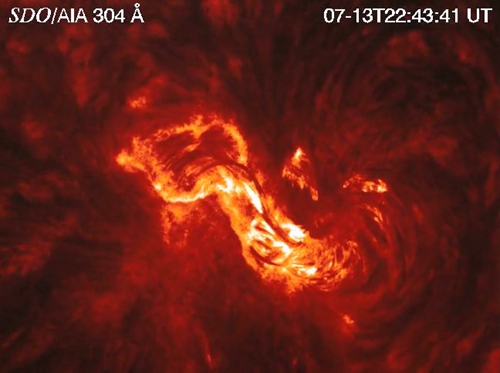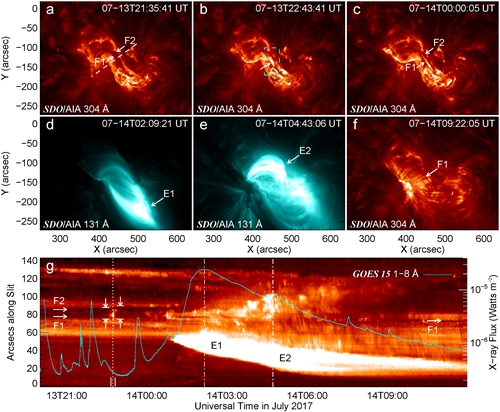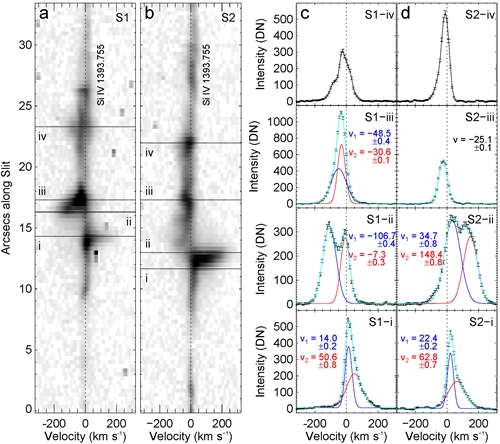Researchers Reveal Definite Spectroscopic Evidence for Magnetic Reconnection in the Splitting of a Solar Filament Structure


Magnetic reconnection is a universal process that changes magnetic topology and converts magnetic energy to plasma kinetic energy. Spatially resolved spectroscopic observations covering extended regions in the solar atmosphere are rare, and thus the distribution and energy partition of reconnection are unclear. A filament is a darker and denser structure in the solar atmosphere. Doppler shifts of bidirectional outflows, as definite evidence for reconnection, have not been detected in solar filament splitting so far.
In Hu et al. (2022), researchers from National Space Science Center of Chinese Academy of Sciences and their collaborators from Max Planck Institute for Solar System Research in Germany and Nanjing University in China, report a magnetic-reconnection event that causes the splitting of a solar filament structure, based on spatially resolved spectroscopic data from the Interface Region Imaging Spectrograph (IRIS) and images from the Solar Dynamics Observatory (SDO).
The filament structure was split into two upper and lower branches by magnetic reconnection,
which eventually erupted partially, with the upper branch ejected and the lower branch retained. The splitting by reconnection was captured on a rare occasion with a spatially resolved IRIS raster scan.
A single Gaussian fit of Si IV 1393.755 Å line profiles in the IRIS data is applied. Neighboring large blue- and redshifts (more than 50 km/s) of the Si IV line in the brightening region between the two filament branches are revealed, which spatially correspond to large nonthermal widths and enhanced intensities of the Si IV line. These are clear signatures of magnetic reconnection. The length of the reconnection region is unprecedentedly no less than 14 000 km.

Clear signatures of magnetic reconnection in the filament splitting observed with IRIS and SDO.
A double Gaussian fit of the line spectra illustrates blue- and redshifts (up to ~150 km/s) of the upward and downward outflows. The reduction of the overall line width indicates that the line-of-sight velocities decrease remarkably after the bidirectional outflows have left the reconnection site. Line broadening on the blue wing several arcseconds away from the reconnection site is observed, which may be indicative of turbulence that is induced when the upward outflow interacts with the upper filament branch.

Spectra of the bidirectional outflows from the reconnection site.
A differential-emission-measure analysis shows that the temperature during the reconnection is ~14 MK, ~9 MK higher than that before the reconnection. The electron density is ~3.9×1010 cm-3, about twice that before the reconnection. The total thermal energy is estimated to be ~1.3×1027 ergs, which is much larger than the kinetic energy.
These discoveries have been published in The Astrophysical Journal Letters. The research has provided definite spectroscopic evidence for the splitting of a filament structure by magnetic reconnection. The reconnection is in an extended region with an unprecedented length. The thermal energy overwhelmingly dominates the kinetic energy in this reconnection event.
Research article information:
Hu Huidong, Liu Ying D, Chitta Lakshmi Pradeep, Peter Hardi & Ding Mingde. Spectroscopic and Imaging Observations of Spatially Extended Magnetic Reconnection in the Splitting of a Solar Filament Structure[J]. The Astrophysical Journal Letters, 2022, 940(1): L12.
DOI: https://doi.org/10.3847/2041-8213/ac9dfd
Contact: Huidong Hu (胡会东), National Space Science Center, Chinese Academy of Sciences, huhd@nssc.ac.cn


